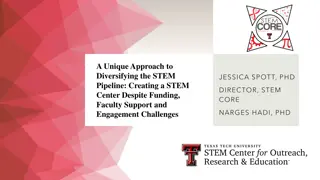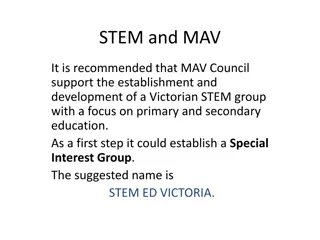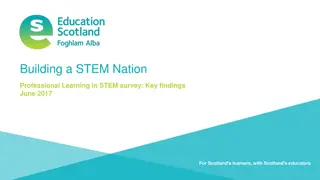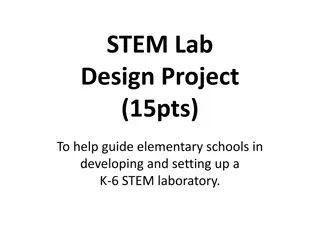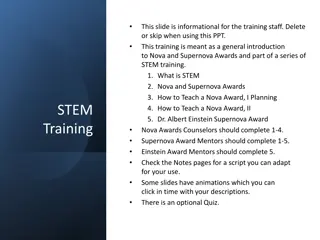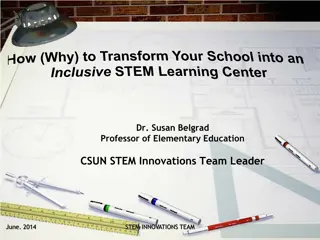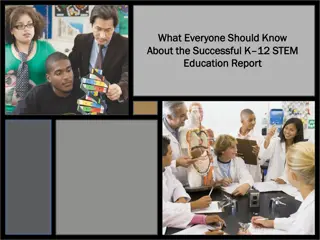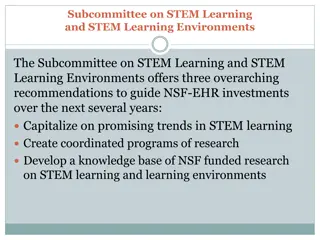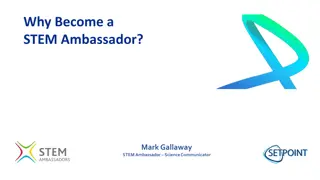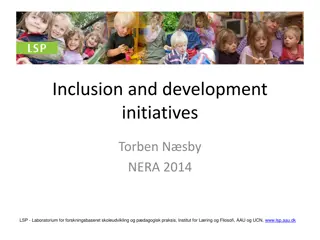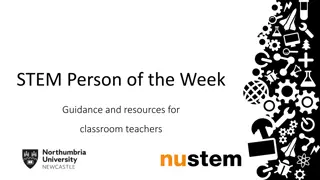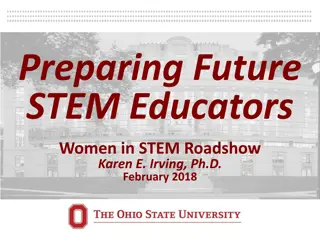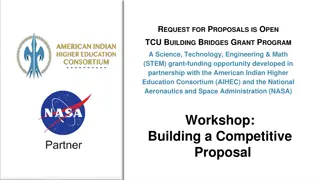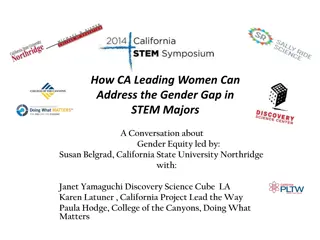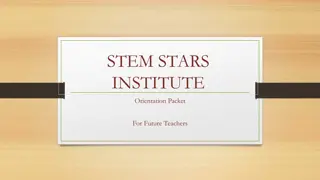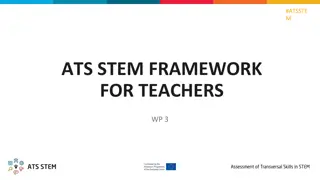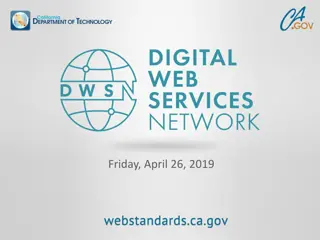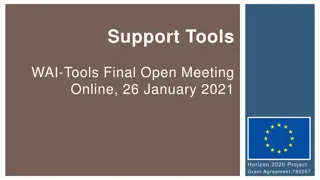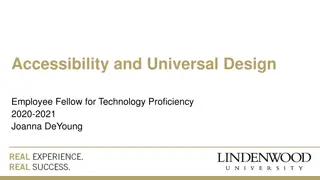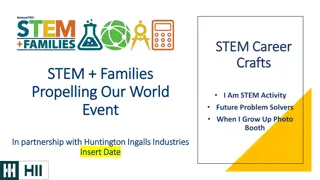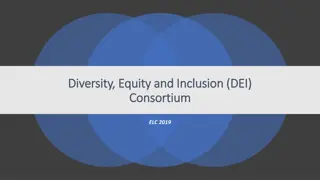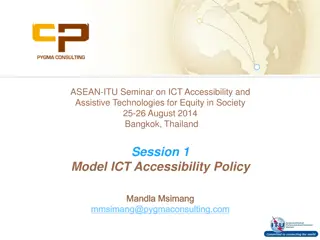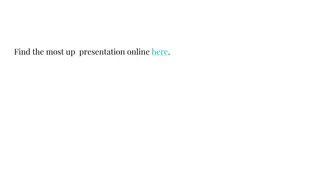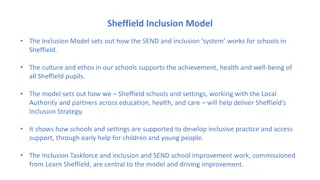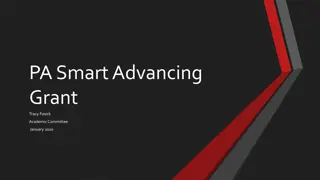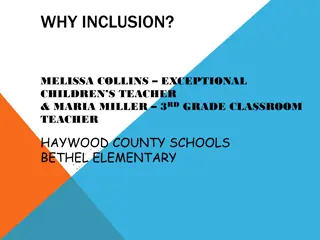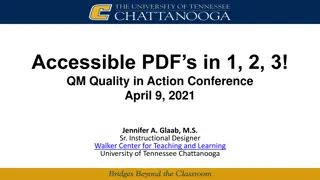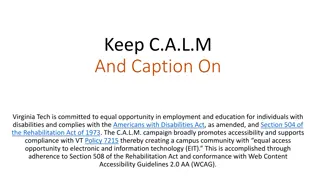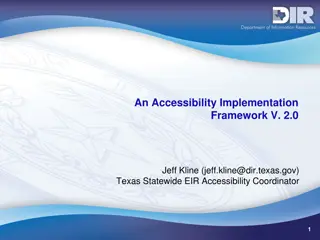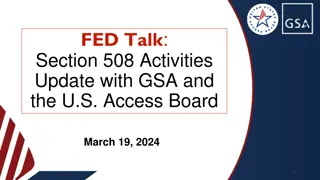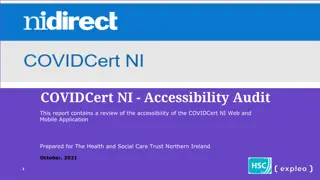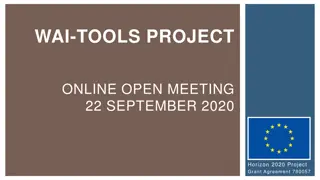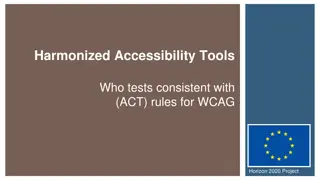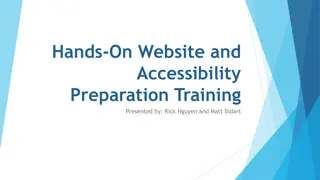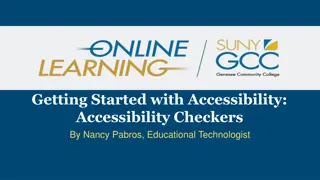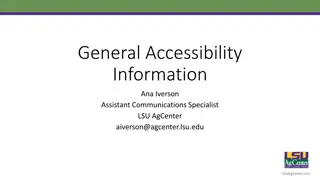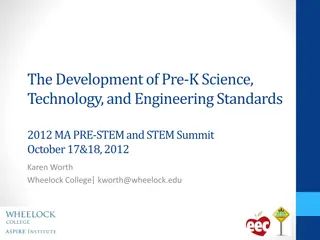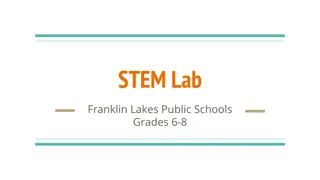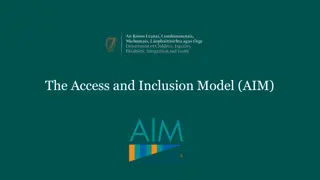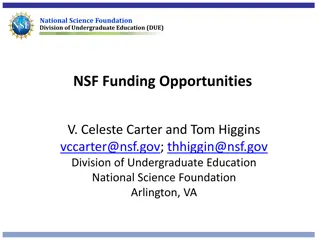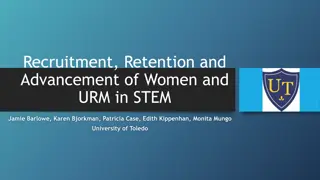Promoting Accessibility and Inclusion in STEM Education
Addressing the needs of students with disabilities in STEM fields is crucial for fostering a diverse and inclusive learning environment. Statistics show a significant percentage of postsecondary students have disabilities, ranging from specific learning disabilities to physical impairments. Understanding the legal framework, individual responsibilities, and available support services is essential for ensuring equal access and participation in STEM education for all individuals.
Download Presentation

Please find below an Image/Link to download the presentation.
The content on the website is provided AS IS for your information and personal use only. It may not be sold, licensed, or shared on other websites without obtaining consent from the author. Download presentation by click this link. If you encounter any issues during the download, it is possible that the publisher has removed the file from their server.
E N D
Presentation Transcript
IMPROVING ACCESSIBILITY AND INCLUSION IN STEM: MEETING THE NEEDS OF STUDENTS WITH DISABILITIES Dr. Nathan W. Moon Mr. Robert L. Todd Dr. Tristan T. Utschig Center for Advanced Communications Policy (CACP), Georgia Institute of Technology Atlanta, Georgia Center for Assistive Technology and Environmental Access (CATEA), Georgia Institute of Technology Atlanta, Georgia Center for the Enhancement of Teaching and Learning (CETL), Georgia Institute of Technology Atlanta, Georgia
Background: Disability Statistics 11% of Postsecondary Students Have a Disability Disability Type Specific Learning Disabilities ADD or ADHD Mental Illness or Psychological/Psychiatric Condition Health Impairment/(Chronic) Condition Mobility Limitation/Orthopedic Impairment Difficulty Hearing Difficulty Seeing Distribution 31% 18% 15% 11% 7% 4% 3%
Background: Disability Statistics (cont.) Disability Type Cognitive Difficulties or Intellectual Disability Autism Spectrum Disorders Traumatic Brain Injury Difficulty Speaking or Language Impairment Other Distribution 3% 2% 2% 1% 3% SOURCES: U.S. Department of Education, National Center for Education Statistics. (2012). Digest of Education Statistics, 2011; Raue, K., and Lewis, L. (2011). Students With Disabilities at Degree-Granting Postsecondary Institutions (NCES 2011 018). U.S. Department of Education, National Center for Education Statistics. Washington, DC: U.S. Government Printing Office.
People with Disabilities and STEM SOURCES: Population and U.S. workforce U.S. Census Bureau, Survey of Income and Program Participation, 2005; Students 6- 17 U.S. Department of Education, Office of Special Education Programs, 2008; Undergraduate and graduate students U.S. Department of Education, National Center for Education Statistics, National Postsecondary Student Aid Study, 2008; STEM doctorate recipients, NSF/SRS, Survey of Earned Doctorates 2008, Workforce and doctoral faculty National Science Foundation, SESTAT data system, and Survey of Doctorate Recipients, 2006.
Laws and Responsibilities High School Post-Secondary Institutions Individuals with Disabilities Act (IDEA) Section 504 of Rehabilitation Act and Americans with Disabilities Act (ADA) Accessibility and Reasonable Accommodations Student Responsibility to Reveal/Provide Documentation of Disability Reasonable Accommodations for Equal Access and Participation Law Free and Appropriate Public Education (FAPE) Responsibility Implementation Individualized Education Plans (IEP) Individualized Instruction, Modifications, Accommodations Services Program Support for Personnel No Formal Program Support Support
Typical Accommodations Alternate Exam Formats or Additional Exam Time (88%) Tutors to Assist with Ongoing Coursework (77%) Readers, Classroom Notetakers, or Scribes (69%) Registration Assistance or Priority Registration (62%) Adaptive Equipment or Technology (58%) Textbooks in Audio Format (55%) Sign Language Interpreters (45%) Course Substitutions or Waivers (42%) SOURCE: National Center for Educational Statistics. [1999]. An institutional perspective on students with disabilities in postsecondary education. Washington DC: U.S. Department of Education.
Universal Design for Learning Emphasis on Accessibility and Inclusion, Rather Than Individual Accommodation Design for All Principles, Suitable for Postsecondary Teaching Principles of Universal Design 1. Equitable Use 2. Flexibility in Use 3. Simple and Intuitive 4. Perceptible Information 5. Tolerance for Error 6. Low Physical Effort 7. Size and Space for Approach and Use
Universal Design for Learning: Examples Class Climate: Syllabi Statements of Diversity/Inclusiveness Interaction: Group Work Requiring Learners to Support Each Other with Value on Different Skills and Roles Physical Environments and Products: Safety Procedures for All Students, Including Those Who Are Blind, Deaf, or Wheelchair Users Delivery Methods: Multiple Modes to Deliver Content Information Resources: Ensure Usability of Web Content Feedback: Permit Feedback Opportunities for Large Projects Assessment: Group Performance, In Addition to Individual Effort Accommodation: Address Needs Not Met by UDL SOURCE: Burghstahler, S. (2004). Universal Design for Instruction. http://www.washington.edu/doit/Faculty/Strategies/Universal/
Resources for Improving Accessibility SciTrain: Science and Math for All SciTrain University BreakThru GRADE: Georgia Tech Research on Accessible Distance Education Accommodating Students with Disabilities in STEM Other Resources
SciTrain: Science and Math for All NSF-funded Project to Train Teachers about Accessible Science, Mathematics, and Computer Science Instruction Intended for High School Teachers Modules Available: Universal design Disability Laws Vision Hearing Learning Disabilities ADHD Autism Spectrum Disorders Mobility and Dexterity Transitioning to University
SciTrain: Science and Math for All Pedagogical Areas Addressed: General Preparation Lectures and Classroom Discussions Classroom Setup Group Work and Assignments Tests and Exams Computer Lab Set-up (Computer Science) Hardware and Software (Computer Science Additional Resources for Accommodations Publications Database on Relevant Literature More Information: http://www.catea.gatech.edu/scitrain
SciTrain University U.S. Department of Education-sponsored Project to Improve Accessibility and Inclusion of Postsecondary STEM Instruction Intended for College and University Faculty, Administrators Modules Available Accessible STEM Teaching 101 Improved Teaching for Large Lectures Improving Online STEM Learning Environments Improving STEM Labs
SciTrain University Universal Design Approach Improving Instruction for All Students Particular Emphasis on Learning Disabilities Emphasis on Accessibility and Inclusion, Not Accommodations Strategies for Classroom, Laboratory, and Fieldwork Instruction, as well as Group Assignments and Testing More Information: http://www.catea.gatech.edu/scitrainu
BreakThru NSF-sponsored Initiative of Georgia STEM Accessibility Alliance Collaboration between Georgia Tech and University of Georgia, with Partners at Georgia Perimeter College and Clarke, Greene, and Gwinnett County High Schools Online Learning Communities for Students with Disabilities Second Life Ning Skype Twitter Online Discussion Groups
BreakThru Community of Mentors and Students to Provide Support, Guidance, Opportunities for Social/Academic Development, and Resources Mentors Include: Secondary Science and Mathematics Teachers Postsecondary STEM Faculty STEM Graduate Students Advanced BreakThru Participants Project Staff Focus on Transition from High School to College and Entry into STEM Workforce
BreakThru More Information: Website: http://www.georgiabreakthru.org Blog: http://blog.georgiabreakthru.org YouTube channel: http://www.youtube.com/user/BreakThruGSAA Facebook page: http://www.facebook.com/BreakThruGSAA
GRADE: Georgia Tech Research on Accessible Distance Education Legacy Project Funded by U.S. Department of Education Intended for Postsecondary Online and Distance Education Programs Modules to Address Accessibility in Distance Education: PowerPoint Video Flash Word documents Excel spreadsheets PDF documents Webpages Scripts and Java
GRADE: Georgia Tech Research on Accessible Distance Education Course Design Models Fact Sheets with Quick Tips, Solutions, and Summary of Issues Guidelines and Legal issues for Accessible Distance Education More information: http://www.catea.gatech.edu/grade/
Accommodating Students with Disabilities in STEM NSF-sponsored Handbook for Educators, Service Providers, Administrators, and Policymakers Synthesis of the Research and Practitioner Literatures on Accommodations and Accessibility in STEM Middle Grades to University Education Audiences Organized by Disability/Functional Ability Category and STEM Discipline FREE Copy: http://www.catea.gatech.edu/scitrain/accommodating.pdf
Other Resources Alternative Media Access Center (AMAC) Electronic Textbooks and Accessible E-text, Braille, Captioning, and Audio Services Georgia Board of Regents (BoR) Membership, with Discounts and Services for USG institutions http://www.amacusg.org/ DO-IT Center at University of Washington AccessSTEM Resources Knowledge Base of Articles, Case Studies, and Promising Practices to Improve Accessibility of STEM http://www.washington.edu/doit/ Observation Instruments from SciTrain U
Conclusion The long-term prosperity of our Nation will increasingly rely on talented and motivated individuals who will comprise the vanguard of scientific and technological innovation. Every student in America deserves the opportunity to achieve his or her full potential. - National Science Board, Preparing the Next Generation of STEM Innovators, 2010
Acknowledgements The authors express their appreciation to Chris Langston, David Morton, Summer Ienuso, and Stephen Rehberg for their contributions to this presentation. We also recognize our BreakThru partners at the University of Georgia, including Noel Gregg and Gerri Wolfe. SciTrain is supported by the National Science Foundation under Grant No. 0622885. SciTrain U is supported by the U.S. Department of Education, Office of Post-Secondary Education, Grant No. P333A080022. BreakThru is supported by the National Science Foundation, Research in Disabilities Education, under Grant No. 1027655. GRADE is supported by the U.S. Department of Education, Office of Post-Secondary Education, under Grant No. P333A020050. Any opinions, findings, and conclusions or recommendations expressed in this material are those of the author(s) and do not necessarily reflect the views of the National Science Foundation or the U.S. Department of Education.


